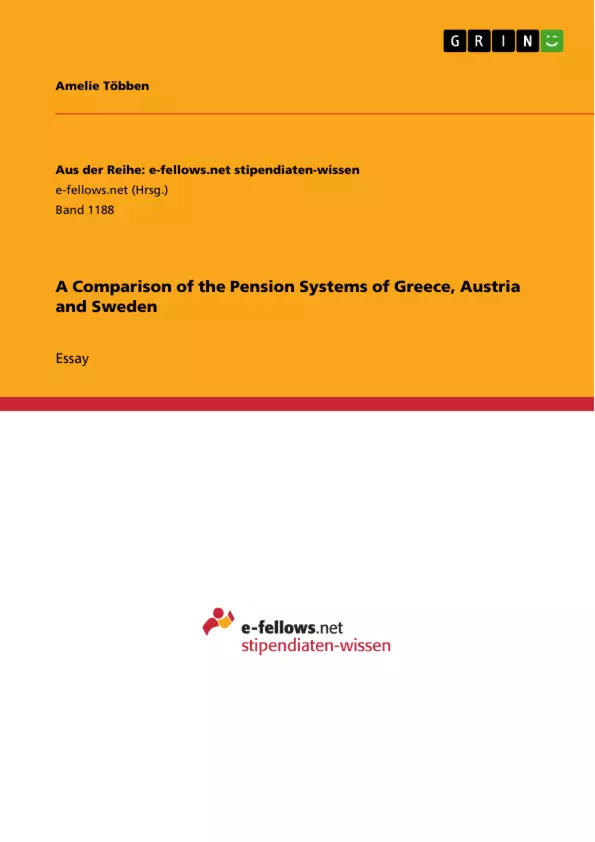The European social model is challenged by decreasing fertility rates, higher life expectancies and the recent financial crisis. As member states are committed to provide sustainable and adequate pensions, they constantly have to review the sustainability of their systems and implement reforms to cope with the population ageing without destabilizing public finances.
For our analysis, we choose the three countries Austria, Greece and Sweden. Our aim was to analyze a variety of different pension systems, not only different in their pension structure but also in their recent sustainability. Consulting the “2014 Pension Sustainability Index” suggests Sweden as a highly sustainable system with minor need for reforms. Austria in the mid-table has a quite sustainable pension system but needs to implement reforms to keep sustainable in the future. Greece made huge improvements in its sustainability due to the recent reforms implemented with the Troika but still remains in the lower field. In our opinion, these three countries give a diversified overview of the European social model.
Inhaltsverzeichnis (Table of Contents)
- Introduction
- Methodology
- Data & proxies
- Baseline scenario
- Sustainable scenario
- Greece
- Baseline scenario
- Policy Changes-forecasts
- Contribution Rate
- Employment
- Austria
- Baseline scenario
- Policy changes
- Sweden
- Baseline Scenario
- Policy Changes-forecasts
- Conclusion
Zielsetzung und Themenschwerpunkte (Objectives and Key Themes)
This term paper analyzes the sustainability of European pension systems, focusing on the specific cases of Greece, Austria, and Sweden. The goal is to evaluate the current state and future prospects of these pension systems in the context of demographic changes, economic challenges, and policy reforms.
- Sustainability of European pension systems
- Impact of demographic changes on pension systems
- Analysis of different pension system structures
- Evaluation of policy reforms and their effectiveness
- Comparison of sustainability across different countries
Zusammenfassung der Kapitel (Chapter Summaries)
- Introduction: This chapter introduces the concept of the European social model, highlighting the challenges posed by decreasing fertility rates, increasing life expectancy, and the recent financial crisis. It then presents the three case studies: Austria, Greece, and Sweden, chosen for their diverse pension systems and sustainability levels.
- Methodology: This chapter outlines the data and proxies used in the analysis. The base year is set to 2010, with data collected from Eurostat and the OECD. The analysis utilizes data on contribution rates, average pensions, number of employees and pensioners, and labor productivity growth to assess the sustainability of each country's pension system.
- Baseline Scenario: This chapter describes the baseline scenario, which assumes no policy changes and uses the collected data to project the future sustainability of the pension systems. The sustainability is assessed by comparing expenditure on pensions to income from wage contributions, considering variables like the number of pensioners, contribution rate, average wage, and number of workers.
- Sustainable Scenario: This chapter introduces a sustainable scenario, where variables are adjusted individually to achieve sustainability. It aims to identify what changes would be needed in areas like wage levels, contribution rates, or other factors to ensure the long-term viability of the pension systems.
- Greece: This chapter presents the specific case of Greece, outlining its three-pillar pension system and the significant reforms undertaken since the economic crisis. It analyzes the baseline scenario, highlighting the growing gap between expenditure and income. The chapter then delves into the potential effects of policy changes like increasing contribution rates and improving employment rates.
- Austria: This chapter focuses on the Austrian pension system, describing its structure and the key elements contributing to its sustainability. It analyzes the baseline scenario and explores the potential need for reforms to maintain sustainability in the future.
- Sweden: This chapter explores the Swedish pension system, known for its high sustainability level. It examines the baseline scenario, highlighting the system's strengths, and discusses any potential policy adjustments for future resilience.
Schlüsselwörter (Keywords)
This study focuses on the sustainability of European pension systems, employing key terms such as demographic changes, population aging, economic challenges, policy reforms, contribution rates, average pensions, employment rates, labor productivity growth, and dependency ratios. The analysis examines specific examples of pension systems in Greece, Austria, and Sweden, highlighting their unique structures and sustainability levels.
- Citar trabajo
- Amelie Többen (Autor), 2014, A Comparison of the Pension Systems of Greece, Austria and Sweden, Múnich, GRIN Verlag, https://www.grin.com/document/299149



